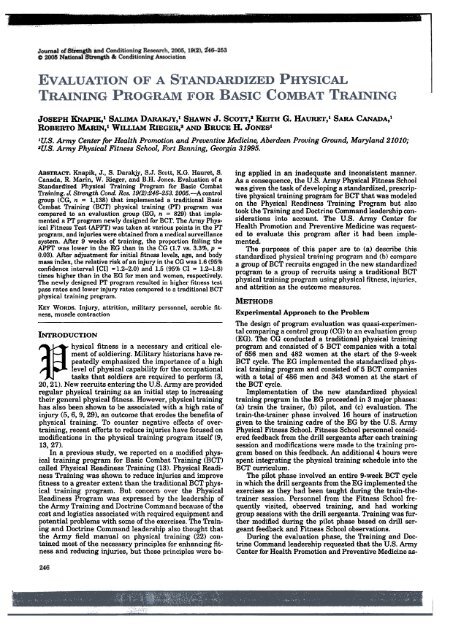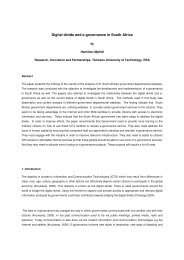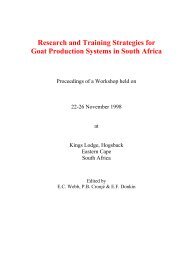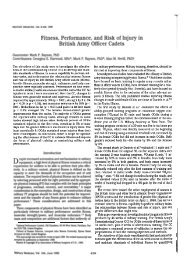Evaluation of a standardized physical training program for
Evaluation of a standardized physical training program for
Evaluation of a standardized physical training program for
Create successful ePaper yourself
Turn your PDF publications into a flip-book with our unique Google optimized e-Paper software.
Journ.t o£S~~and Conditioning Research, 2005, 19(2), 2'46-253<br />
C 2O05NationalS~gth& Conditioning Association<br />
JOSEPH KNAPIK,1 SALIMA DARAKJY,l SHAWN J. SCOTT,2 KEITH G. HAURET,I SARA CANADA,1<br />
RoBERTO MARIN,1 WILLIAM RIEGER,2 AND BRUCE H. JONES1<br />
'US. Army Center fi>r Health Promotion and Preventive Medicine; Aberdeen Proving Ground, Maryland 21010;<br />
zUS. Army Physical Fitness School, Fort Benning, Georgia 31995.<br />
ABSTRACT. Knapik, J., S. Darakjy, S.J. Scott, KG. Hauret, S. ing applied in an inadequate and inconsistent manner.<br />
Canada, R. Marin, W. Rieger, and B.H. Jones. <strong>Evaluation</strong> <strong>of</strong> a As a consequence, the U.S. Army Physical Fitness School<br />
Standardized Physical Training Program <strong>for</strong> Basic Combat was given the task <strong>of</strong> developing a <strong>standardized</strong>, prescrip-<br />
Training. J: Strength Condo Res. 19(2):246-253. 2005.-A control<br />
group (CG, n = 1,138) that implemented a traditional Basic tive <strong>physical</strong> <strong>training</strong> <strong>program</strong> <strong>for</strong> BCT that was modeled<br />
Combat Training (BCT) <strong>physical</strong> <strong>training</strong> (PT) <strong>program</strong> was<br />
on the Physical Readiness Training Program but also<br />
compared to an evaluation group (EG, n = 829) that imple- took the Training and Doctrine Command leadership conmented<br />
a PT <strong>program</strong> newly designed <strong>for</strong> BCT. The Army Physsiderations into account. The U.S. Army Center <strong>for</strong><br />
ical Fitness Test (APFT) was taken at various points in the PT Health Promotion and Preventive Medicine was request-<br />
<strong>program</strong>, and injuries were obtained from a medical surveillance ed to evaluate this <strong>program</strong> after it had been imple-<br />
system. After 9 weeks <strong>of</strong> <strong>training</strong>, the proportion failing the mented.<br />
APFT ,vas lower in the EG than in the CG (1.7 vs. 3.3%, p =0.03). The purposes <strong>of</strong> this paper are to (a) describe this<br />
After adjustment <strong>for</strong> initial fitness levels, age, and body <strong>standardized</strong> <strong>physical</strong> <strong>training</strong> <strong>program</strong> and (b) compare<br />
ma..ors index, the relative risk <strong>of</strong> an injury in the CG was 1.6 (95%<br />
confidence interval [CI] =1.2-2.0) and 1.5 (95% CI = 1.2-1.8)<br />
a group <strong>of</strong> BCT recruits engaged in the new <strong>standardized</strong><br />
times higher than in the EG <strong>for</strong> men and women, respectively.<br />
<strong>program</strong> to a group <strong>of</strong> recruits using a traditional BCT<br />
The newly designed PT <strong>program</strong> resulted in higher fitness test <strong>physical</strong> <strong>training</strong> <strong>program</strong> using <strong>physical</strong> fitness, injurieR.<br />
pass rates and lower injury rates compared to a traditional BCT and attrition as the outcome measures.<br />
<strong>physical</strong> <strong>training</strong> <strong>program</strong>.<br />
KEY WORDS. Injury, attrition, military personnel, aerobic fitness,<br />
muscle contraction<br />
METHODS<br />
Experimental Approach to the Problcm<br />
The design <strong>of</strong> <strong>program</strong> evaluation was quasi-experimen-<br />
INTRODUCTION~<br />
hysical ment <strong>of</strong> fitness soldiering. is a Military necessary historians and critical have ele- retal<br />
comparing a control group (CG) to an evaluation group<br />
(EG). The CG conducted a traditional <strong>physical</strong> <strong>training</strong><br />
<strong>program</strong> and consisted <strong>of</strong> 5 BCT companies with a total<br />
<strong>of</strong> 656 men and 482 women at the start <strong>of</strong> the 9-week<br />
peatedly emphasized the importance <strong>of</strong> a high BCT cycle. The EG implemented the <strong>standardized</strong> phys-<br />
level<br />
tasks<br />
<strong>of</strong> <strong>physical</strong> capability <strong>for</strong><br />
that soldiers are required<br />
the occupational<br />
to per<strong>for</strong>m {3,<br />
ical <strong>training</strong> <strong>program</strong> and consisted <strong>of</strong> 5 BCT companies<br />
with a total <strong>of</strong> 486 men and 343 women at the start <strong>of</strong><br />
20, 21). New recruits entering the U,S. Army are provided the BCT cycle.<br />
regular <strong>physical</strong> <strong>training</strong> as<br />
their general <strong>physical</strong> fitness.<br />
an initial<br />
However,<br />
step to increasing<br />
<strong>physical</strong> <strong>training</strong><br />
Implementation <strong>of</strong> the new <strong>standardized</strong> <strong>physical</strong><br />
<strong>training</strong> <strong>program</strong> in the EG proceeded in 3 major phases:<br />
has also been shown to be associated with a high rate <strong>of</strong> (a) train the trainer, (b) pilot, and (c) evaluation. The<br />
injury (5,6, 9, 29), an outcome that erodes the benefits <strong>of</strong> train-the-trainer phase involved 16 hours <strong>of</strong> instruction<br />
<strong>physical</strong> <strong>training</strong>. To counter negative effects <strong>of</strong> over- given to the <strong>training</strong> cadre <strong>of</strong> the EG by the U.S. Army<br />
<strong>training</strong>, recent ef<strong>for</strong>ts to reduce injuries have focused on Physical Fitness School. Fitness School personnel consid-<br />
modifications in<br />
13, 27).<br />
In a previous<br />
the <strong>physical</strong><br />
study, we<br />
<strong>training</strong><br />
reported<br />
<strong>program</strong> itself (9,<br />
on a modified physered<br />
feedback from the drill sergeants after each <strong>training</strong><br />
session and modifications were made to the <strong>training</strong> <strong>program</strong><br />
based on this feedback. An additional 4 hours were<br />
ical <strong>training</strong> <strong>program</strong> <strong>for</strong> Basic Combat Training (BCT) spent integrating the <strong>physical</strong> <strong>training</strong> schedule into the<br />
called<br />
ness<br />
Physical<br />
Training<br />
Readiness<br />
was shown<br />
Training<br />
to reduce<br />
(13). Physical<br />
injuries and<br />
Readi-<br />
improve<br />
BCT curriculum.<br />
The pilot phase involved an entire 9-week BCT cycle<br />
fitness to a greater extent than the traditional BCT phys- in which the drill sergeants from the EG implemented the<br />
ical <strong>training</strong> <strong>program</strong>. But concern over the Physical exercises as they had been taught during the train-the-<br />
Readiness<br />
the Army<br />
Program<br />
Training<br />
was expressed by the<br />
and Doctrine Command<br />
leadership <strong>of</strong><br />
because <strong>of</strong> the<br />
trainer session. Personnel from the Fitness School frequently<br />
visited, observed <strong>training</strong>, and had working<br />
cost and<br />
potential<br />
logistics<br />
problems<br />
associated with required equipment<br />
with some <strong>of</strong> the exercises. The<br />
and<br />
Train-<br />
group sessions with the drill sergeants. Training was further<br />
modified during the pilot phase based on drill sering<br />
and Doctrine Command leadership also thought that geant feedback and Fitness School observations.<br />
the Army field manual on <strong>physical</strong> <strong>training</strong> (22) con- During the evaluation phase, the Training and Doctained<br />
most <strong>of</strong> the necessary principles <strong>for</strong> enhancing fittrine Command leadership requested that the U.S. Army<br />
ness and reducing injuries, but these principles were be- Center <strong>for</strong> Health Promotion and Preventive Medicine as-<br />
246
'ifi"<br />
'..." .;<br />
~~,,~;:<br />
'if;:<br />
:<br />
, PROGRAM FOR BASIC COMBAT TRAINING 247<br />
.c'c"<br />
TAm.B 1. Pbysi~F~~ng<strong>program</strong> <strong>of</strong> the evaluation group<br />
(further details can~:pbtairted from Knapik et al. [11]*).<br />
Exercise<br />
Conditioning drill 1.<br />
Bend-and-reach<br />
Rear lunge<br />
High jumper<br />
Rower<br />
Knee-bender<br />
Windmill<br />
Forward lunge<br />
Prone row<br />
Supine bicycle<br />
Push-up<br />
Conditioning drill 2<br />
Push-up<br />
Sit-up<br />
Pull-up<br />
Movement drills<br />
Verticals<br />
Laterals<br />
Sh\lttle sprints<br />
Ability group running<br />
Speed running<br />
Stretching drills<br />
Groin stretch<br />
Calf stretch<br />
Hamstrinlt stretch<br />
Thigh stretch<br />
Hip-nrea strctch<br />
Ovcrhcnd arm pull<br />
Tum-nnd.rcltch<br />
Hip ncxor Rtrctch<br />
Exwnd-and-flcx<br />
Single lcg-
,<br />
Week<br />
;~<br />
\~:~<br />
c<br />
D<br />
30:.60<br />
6:<br />
30:.60<br />
4<br />
30:60<br />
4<br />
30:60<br />
ETAL.<br />
Week 2<br />
first number in each cell represents the number <strong>of</strong> repetitions, and the second number<br />
3 Week 4-- Week 5 Week 6 Week 7<br />
WeekS \Veek 9<br />
repetitions <strong>of</strong> each exercise were per<strong>for</strong>med, and trainees Outcome Measures<br />
progressed to 10repetitions.<br />
Standard conditioning drill 2 consisted <strong>of</strong> 3 exercises<br />
desigI1ed to develop upper-body strength and endurance,<br />
Exercises included push-ups, sit-ups, and pull-ups per<strong>for</strong>med<br />
in the sequence listed. Push-ups and sit-ups were<br />
per<strong>for</strong>nled in cadence starting with 54-count repetitions<br />
and progressing over time to 20 4-count repetitions. Pullups<br />
were per<strong>for</strong>med in cadence <strong>for</strong> 52-count repetitions<br />
using spotters and progressing to 52-count repetitions<br />
unassisted.<br />
Standard movement drills involved 3 exel"Cises designed<br />
to assist the trainees In maneuvering their bodies<br />
through space in unusual ways and to assist them in developing<br />
motor efficiency. Movement drills included verticals,<br />
laterals, and shuttle sprints per<strong>for</strong>med over a distance<br />
<strong>of</strong> about 25 yards. At se.lcctcd points in the <strong>training</strong><br />
<strong>program</strong>, trainees penormed a 300-yard shuttle run in<br />
which they lined up in ranks,ran 25 yards, touched a line<br />
on the ground with their hand, andrcturned to the starting<br />
point, where they touched the start/finish line. This<br />
was 1 repetition. Trainees penormed a total <strong>of</strong> 6 shuttle<br />
run repetitions in a single bout,<br />
Standard ability gI'oup l'Unning was llsed to develop<br />
cardiorespiratory endurance. Ability groups were 4 aggregates<br />
<strong>of</strong> trainees with similar run speeds as determined<br />
by a I-mile test taken at the start <strong>of</strong> <strong>training</strong>.<br />
Speeds and distances were progressively increased<br />
throughout <strong>training</strong> on a predetermined schedule, shown<br />
in Table 2. Besides long-distance running, speed running<br />
(interval <strong>training</strong>) \vas used to develop anaerobic capacity<br />
and faster running speeds. At the start <strong>of</strong> <strong>training</strong>, speed<br />
running involved 4~6 sprint repetitions (depending on<br />
ability group) at a work:rest ratio <strong>of</strong> 1:2 (run:walk). The<br />
number <strong>of</strong> repetitions was gradually increased to 10 over<br />
the course <strong>of</strong> BOT, and the duration <strong>of</strong> the work cycle was<br />
increased from 30 to 60 seconds. Details <strong>of</strong> the speed running<br />
progression are shown in Table 3,<br />
Standard stretching drills (Table 1) were part <strong>of</strong> the<br />
cool-down and were designed to assist trainees in controlling<br />
postexercise stiffness, Stretching drills involved<br />
static stretches that \'{ere each held <strong>for</strong> 30 seconds.<br />
Stretching drills conducted at the conclusion <strong>of</strong> physic~l<br />
<strong>training</strong> on cardiovascular days included the groin<br />
stretch, calf stretch, hamstring stretch, thigh stretch, and<br />
hip-area stretch. Stretching drills conducted at the conclusion<br />
<strong>of</strong> <strong>physical</strong> <strong>training</strong> on muscle strength/endurance<br />
days included the overhead arm pull, the turn and reach,<br />
hip flexor stretch, the extend-and-flex, and the single legover.<br />
Ol1ctcome measures selected <strong>for</strong> this <strong>program</strong> evaluation<br />
included assessments <strong>of</strong> <strong>physical</strong> fitness, injuries, and attrition.<br />
All outcome measures were obtained from existing<br />
data sources routinely maintained by other organizations.<br />
Physical Fitness. Two types <strong>of</strong> <strong>physical</strong> fitness tests<br />
were employed. The first type was the Initial Fitness Assessment<br />
consisting <strong>of</strong> a 1-minute maximal ef<strong>for</strong>t pushup<br />
event, a I-minute maximal efl'ort sit-up event, and a<br />
I-mile run <strong>for</strong> time. The Initial Fitness Assessment was<br />
administered to recruits \vithin 1-3 days <strong>of</strong> arrival at the<br />
BOT unit. The second type <strong>of</strong> fitness test was the Army<br />
Physical Fitness Test (APIi'T), consisting <strong>of</strong> n 2-minut
Time between events was no less than 10 minutes and no<br />
more than 20 minutes.<br />
Injuries. Injuries were obtained from the Anny Medical<br />
Surveillance Activity that warehouses data from the<br />
Standard Ambulatory Data Record (SADR), which contains<br />
all outpatient medical visits made by Army personnel.<br />
Each time a trainee saw a medical care provider at<br />
the Troop Medi24). For all categorical variables, simple contrasts<br />
with a baseline variab]e (dcfined with a risk ratio<br />
<strong>of</strong> 1.00) were used.<br />
RESUI..TS<br />
1'he <strong>physical</strong> characteristics <strong>of</strong> the CG and EG are sho\vn<br />
in Table 4. ,!'he groups were very similar on all <strong>physical</strong><br />
characteristics. At the start <strong>of</strong> BCT, the proportion <strong>of</strong><br />
women in the CG was 42.4%, while that <strong>of</strong> the EG \vas<br />
41.4rk (p = 0.66). At the conclusion <strong>of</strong> <strong>training</strong>, the proportion<br />
<strong>of</strong> women in the CG was 39.9%, \vhile that <strong>of</strong> the<br />
EG was 37.8"/c, (p = 0.40).<br />
Physical Fitness Outcomes<br />
Table 5 shows the Initial Fitness Assessment scores <strong>of</strong> the<br />
2 groups. Men and women in the EG per<strong>for</strong>med an average<br />
<strong>of</strong> 2 more push-ups in a minute than those in the<br />
CG, and this difference was statistically significant.<br />
There were no group differences on sit-ups or the 1-mile<br />
run.<br />
Table 6 shows the APFT scores <strong>of</strong> the CG and EG at<br />
weeks 5 and 7. Since there were initial group differences<br />
on push-ups (Table 4), ANCOV A was used <strong>for</strong> analysis <strong>of</strong><br />
this test event with adjustment <strong>for</strong> push-up scores on the<br />
Initial Fitness Assessment. The ANCOVA showed no significant<br />
group-by-week interaction (p = 0.13 <strong>for</strong> men, p<br />
= 0.58 <strong>for</strong> \vomen). There was an improvement from \veek<br />
5 to week 7 (p < 0.01 <strong>for</strong> both men and women). The EG<br />
demonstrated higher push-up per<strong>for</strong>mance than the CG<br />
(p < 0.01 <strong>for</strong> men and p = 0.02 <strong>for</strong> women). Overall, the<br />
results indicate that <strong>for</strong> both men and women, push-up<br />
per<strong>for</strong>mance <strong>of</strong> the EG was higher than that <strong>of</strong> the CG at
'..,<br />
~"<br />
:;f~_t<br />
ETAL.<br />
.p value compares CG and EG using an independent-samples i-test.<br />
t BM! = body mass index.<br />
TABLE 5. Comparison <strong>of</strong> Initial Fitness Assessment scores <strong>of</strong><br />
the control group (CG) and the evaluation group (EG).<br />
Men Women<br />
Push-tipS CG<br />
(/I) EG<br />
Sit-ups CG<br />
(/II EG<br />
I-mi. run CG<br />
(min) EG<br />
28<br />
30<br />
31<br />
31<br />
8.4<br />
8.4<br />
1.1<br />
1.1<br />
7<br />
7<br />
1.2<br />
1.4<br />
Incidence<br />
rate<br />
(injuries!<br />
1,000<br />
trainee-days)<br />
5.223.41<br />
p value*<br />
Incidence<br />
rate<br />
(injuries!<br />
1,000<br />
trainee-days) p value.<br />
CO<br />
9.24 0.04<br />
EO<br />
7.22<br />
.Compares CO and EG using a chi-square test. <strong>for</strong> incidence<br />
rates (I),<br />
TABLE 9. Comparison <strong>of</strong> relative injury risk in the control<br />
;;"mp (CG) and the evaluation group (~~) (from Cox regression).<br />
Multivariatet<br />
1.29-2.091.21-1.82<br />
Men<br />
Women<br />
Men<br />
Women<br />
~. From Wald statistic.<br />
"'" t.'Iultivariatc modcl includes age, body mass index, and lniti..IJ<br />
Fitncfifi Assessment variables.<br />
TARLK 10. Comparison <strong>of</strong> attrition (dischargcs and newstarts)<br />
in the control ""roup (CG) find the cvaluntion group (EG).<br />
Attrition Altrition<br />
(~,) p vmue* (~,) p vmu(!*<br />
retakes, but this was statisticalLy significant only after all<br />
-retakes had been completed.. Likewise, the EG women<br />
had a higher APFT pass rate throughout, but this was<br />
statistically significant only at weeks 5 and 7. When men<br />
and women were combined, the proportion <strong>of</strong> recruits<br />
passing the APFT was higher <strong>for</strong> the EG than <strong>for</strong> the CG<br />
at all test periods.<br />
Injury Outcomes<br />
Table 8 shows the person-time injury incidence rates <strong>for</strong><br />
the 2 groups. For both men and women, injury incidence<br />
rates were significantly higher in the CG than in the EG.<br />
Table 9 shows the univariate and multivariate Cox regression<br />
results. Injury risk was higher in the CG than<br />
in the EG <strong>for</strong> both univariate and muLtivaz;ate analyses.<br />
Attrition Outcomes<br />
1.21-1.98<br />
1.l.~1..82<br />
Table 10 shows the proportion <strong>of</strong> recruits who did not<br />
complete BOT with their peers during the 9-\veek BOT<br />
cycle. There were no significant differences between the<br />
CG and EG.<br />
DISCUSSION<br />
PROGRAM FOR BASIC COMBAT TRAINlKG 251<br />
The EG recruits who trained according to the new <strong>standardized</strong><br />
<strong>physical</strong> <strong>training</strong> <strong>program</strong> had more favorable<br />
<strong>training</strong> outcomes than the CG recruits who used a traditional<br />
<strong>physical</strong> <strong>training</strong> <strong>program</strong>. The EG had lo,ver injury<br />
risk, a higher APFT pass rate at week 7, and a higher<br />
APFl' pass rate after all APFl' retakes had been completed.<br />
There were no significant group differences in attrition.<br />
The EG demonstrated higher push-up perfolmance<br />
than the CG at weeks 5 and 7, even after correction <strong>for</strong><br />
the higher initial scores <strong>of</strong> the EG. A previous BCT <strong>physical</strong><br />
<strong>training</strong> investigation evaluated a <strong>program</strong> similar to<br />
the one tested here (13) but \vith less emphasis on pushup<br />
<strong>training</strong>. In that previous evaluation, the push-up per<strong>for</strong>mance<br />
<strong>of</strong> the group using a special <strong>training</strong> <strong>program</strong><br />
was lower than that <strong>of</strong> a group using a traditional <strong>physical</strong><br />
<strong>training</strong> <strong>program</strong>. In the present evaluation. more<br />
emphasis was placed on push-up <strong>training</strong>, and this may<br />
have accounted <strong>for</strong> the higher push-up per<strong>for</strong>mance <strong>of</strong> the<br />
EG. There were some group differences on sit-ups and the<br />
2-mile run on week 5, but by week 7 the per<strong>for</strong>mances <strong>of</strong><br />
the 2 groups were similar.<br />
In consonance with our previous investigation (13),<br />
the similar 2-mile run per<strong>for</strong>mances <strong>of</strong> the EG and CG at<br />
week 7 appears to have been achieved with fewer total<br />
running miles on the part <strong>of</strong> the EG. In the present pro.<br />
gram evaluation, total running mileage in the CG was<br />
estimated from the <strong>training</strong> schedules that were kept by<br />
the individual companies. The EG had mandated running<br />
distances that required strict adhcrence. Total running<br />
distances during BCT <strong>for</strong> the fastest and slowest <strong>of</strong> the 4<br />
ability groups in the EG were 39 and 26 miles, respectively.<br />
Total running mileages <strong>of</strong> the CG were 44 and 34<br />
miles, <strong>for</strong> the fastest and s1owest abi1ity I,7fOUPS, respectively.<br />
Thus, the slowest EG ability group ran an estimated<br />
8 fewer miles (31i>f, less) than the slowest CG; the<br />
fastest EG ability group ran an estimated 5 fewer miles<br />
(13% less) than the fastest CG. Speed running per<strong>for</strong>med<br />
by EG trainees probably assisted in improving APFT 2mile<br />
run speed in light <strong>of</strong> this reduced total running mileage.<br />
Speed running is referred to as interval <strong>training</strong> in<br />
general exercise physiology literature (4, 30). Inter\'al<br />
<strong>training</strong> has been shown to result in greater improvements<br />
in running speed than long-distance running<br />
alone, especially in initially sedentary and recreationally<br />
active individuals (17).<br />
Person-time injury incidence rates and the univariate<br />
analysis <strong>of</strong> injury risk by Cox regression all showed lower<br />
injury rates and risks in the EG compared to the CG.<br />
Even when age, BMI, and initial fitness were included in<br />
a multivariate analysis, the EG still had lower injulJ' risk.<br />
This is in general agreement with our previous investigation<br />
(13). The lower injury rates in the EG may be associated<br />
with certain characteristics <strong>of</strong> the <strong>physical</strong> <strong>training</strong><br />
<strong>program</strong> that include (a) a lower total amount <strong>of</strong> running;<br />
(b) the gradual, progressive introduction <strong>of</strong> exercise<br />
stress; and (c) the greater variety <strong>of</strong> exercise in the <strong>program</strong>.<br />
As noted previously, the EG ran fewer miles than<br />
the ca. Numerous studies have demonstrated an association<br />
between higher injUl'Y rates and longer running<br />
distances (5, 15, 16, 18, 24, 27, 29). Studies in Army,<br />
Navy, and Marine basic <strong>training</strong> have demonstrated that<br />
groups with lower running mileage have lower injury
~~'~~<br />
"'c.t~~<br />
ET:AI<br />
In run test times com-<br />
.distances (5, 27, 29).<br />
". "c.c speed running was a key feature<br />
<strong>of</strong>thestandardizeq;...<strong>physical</strong> <strong>training</strong> <strong>program</strong>. A number<br />
<strong>of</strong> studies (12, 13.,c~~., 26) have suggested that increased<br />
time devoted toin~rval traini~g and decreased time devoted<br />
to distance ~nning is ~ssociated with less likelihood<br />
<strong>of</strong> injuries in BOT, possibly because less total distance<br />
is run (5). However, all these previous studies (12,<br />
13, 23, 26) were confounded with multiple interventions,<br />
making it difficult to determine the influence <strong>of</strong> interval<br />
<strong>training</strong> alone on injUI"y risk.<br />
Another feature <strong>of</strong> the new ph)'sical <strong>training</strong> <strong>program</strong><br />
that may have influenced injury rates was the gradual<br />
introduction <strong>of</strong> the exercises following the principle <strong>of</strong><br />
The data here also rein<strong>for</strong>ce the importance <strong>of</strong> following<br />
basic principles <strong>of</strong> exercise prescription (19, 30) when<br />
individuals are starting a new exercise <strong>program</strong>. In BCT,<br />
it is not possible to tailor exercise <strong>program</strong>s to individual<br />
needs because <strong>of</strong> the large number <strong>of</strong> trainees, the limited<br />
number <strong>of</strong> trainers, and the requirement to maintain control<br />
<strong>of</strong> personnel at all times. However, it is possible to<br />
tailor <strong>program</strong>s to grOllpS <strong>of</strong> individuals with similar fitness'levels<br />
\vho can exercise together. Because many individuals<br />
are relatively sedentary on arrival at BCT, the<br />
<strong>program</strong> must start gradually and progress to higher exercise<br />
intensities over time. A high vo]ume <strong>of</strong> running is<br />
not necessary to improve aerobic fitness; inc]uding more<br />
interval <strong>training</strong> may assist in reducing running mileage<br />
(high mileage is associated with high injury incidence)<br />
progressive overload (19), Training drills per<strong>for</strong>med by while enhancing aerobic fitness,<br />
the EG were initiated slowly, and the number <strong>of</strong> repetitions<br />
was increased gI'adual]y over the <strong>training</strong> sessions. REFERENCES<br />
Running mileage was gradually incrensed on a preset<br />
schedule <strong>for</strong> each <strong>of</strong> the ability gI"OUPS, lIS was the number<br />
<strong>of</strong> repetitions in the interval <strong>training</strong>. It should be noted<br />
that while the principle <strong>of</strong> progressive overload has widespread<br />
endorsement among trainers nnd exercise physiologists<br />
(2, 19,30), there is only 1 study (25) that suggests<br />
that this technique reduces injuries. I{i('l~ et al. (25) compared<br />
2 grOllpS <strong>of</strong> soldiers t~itling to he medics. One<br />
1.<br />
2.<br />
3.<br />
4.<br />
AHI.DOM A., AND S. NOREI.L. In/rod/lc/;on /0 Moder/J Epidemiology.<br />
ChcstmJt Hill, MA: Epidcmiologicnl Rcsourccs Inc., 1984.<br />
ARNHEIM, D.O., AND \V.E. PRI.:NTICR. Pril/cipl~8 <strong>of</strong> Athletic<br />
Trail/iI/g. St. Louis, MO: Mosby-Year Book, 1993.<br />
DUBIK, J.M., AND 'r.D. FUU.J.:R'f()N. Soldier ovcrloading in Grcnndll.<br />
Mil. Reu 67:38-47. 1987.<br />
Fox, E.L., AND D.K. MATIJ\.;WS. InlcrIXl17'minil/g: ConcliliollinJ(<br />
<strong>for</strong> Sport.'! al/d Gel/ffal Fillll'.".'I. Philadclphia: W.B. SnundcnI,<br />
group introduccd rllnning in a gradual, progressive man- )974.<br />
ner, and the other group essentially rnn a similar dis- 5. JONt"S, B.H., D.N. CO\VAN, ANI) J.J. KNAI'IK. Excrcil'
14. KNAPIK, J.J., M.A. SHARP, M.L. CANHA:.I, K HAURET, J. CUTH-<br />
IE, W. HEWITSON, E. HOEDEBI;:CKE, M.J. LAURIN, C. POLYAK,<br />
D. CARROLL, AND B. JONES. I/\iury Incidence and I/\iury Risk<br />
Factors Among US Army Basic ,Trainees at Ft Jackson, SC (Including<br />
Fitness Training U,ut Personnel, Discharges, and New.<br />
starts). Epidemiological Consultation Report No. 29-HE-8370-<br />
99. Aberdeen Proving GrouncJ MD: U.S. Anny Center <strong>for</strong><br />
Health Promotion and Preventive Medicine, 1999.<br />
15. KoPLAN, J.P.. KE. POWELL, R.K. SIKES, R.W. SHIRLEY. AND<br />
C.C. CAlwIPBELL. An epidemiologic study <strong>of</strong> the benefits and<br />
.risks <strong>of</strong> running. .l Am. Med- Assoc. 248:311s.,.3121. 1982.<br />
16. KoPLAN, J.P., R.B. ROTf(ENBfo~ltG. AND E.L. JONES. The natural<br />
history <strong>of</strong> exercise: A 10-yr follow-up <strong>of</strong> a cohort <strong>of</strong> runners.<br />
Med. Sci. Sports E.wrc. 27:1180-1184. 1995.<br />
17. LAURSEN, P.B., AND D.G. JENKINS. The scientific basis <strong>for</strong> high<br />
intensity interval <strong>training</strong>: Optimizing <strong>training</strong> <strong>program</strong>mes<br />
and maximising per<strong>for</strong>mance in highly trained endurance ath-<br />
18.<br />
lotes. Sport.~ Med. 32:53-73. 20()2.<br />
MARTI, B., J.P. VADER, C.E. MINDER, AND T. ABEUN. On the<br />
epidemiology <strong>of</strong> running injuries: The 1984 Bern Grand-Prix<br />
study. Am. J. Sports Med. 16:285-294. 1988.<br />
19. McARDLE, W.D., F.I. KATCH, AND V.L. KATCH E.rercise Physi.<br />
ology: Energy, Nutrition mm HunlOn Per<strong>for</strong>mance. Philadel-<br />
20.<br />
phia: Lea & Febiger, 1991.<br />
MCCAIG, It.H., AND C.Y. Go(>DEIt.~ON. Ergonomic and physiological<br />
aspects <strong>of</strong> military<br />
gonolll;(:s 29:849-857.1986.<br />
ojJerations in a cold wet climate. Er-<br />
21. NYI-:, R.H. 'l'llc Challcllge <strong>of</strong> Command. Wayne, NJ: Avcry Publisbing<br />
GI"OUP, 1986.<br />
22. PHYSI(;AI. FI1'Nf':'-;'~ TIIAININO. U.S. Army Field Mnnual (FM) 21-<br />
20. Washinl,.Yton, DC: Hcadqullrtel"S.<br />
1992.<br />
Dopnrtmcnt <strong>of</strong> the Army,<br />
23. POI'f':, R. P. Prevention <strong>of</strong> pelvic fltl"CSS frl\cturcs in female Army<br />
recruit-'!. Mil. Merl. 164:370-.173. 1999.<br />
24. POWf':I.I., K.I~., H.W. KOIII., C.,J.. CAHI'f';IISI':N. ANII S.N. 13I.1\II!.<br />
An epidemiologic-'ll PCrsl>cctivc on the cmtws c1f ,'unning injuries.<br />
Phy.'Iu'iml .S'port.'1III,'rl. 14(61:100-114. 1~)R6.<br />
PROGRAM FOR BASIC COMBAT TRAINING 253<br />
25. RICE, V.J.B., V. CONNOLLY, A. BERGERON, M.Z. MAyS, G.M.<br />
EvANS-CliRlSTOPHER. B.D. ALLGOOD, AJ."D S. ~lICI
















